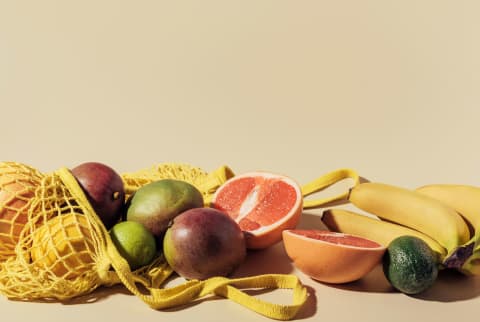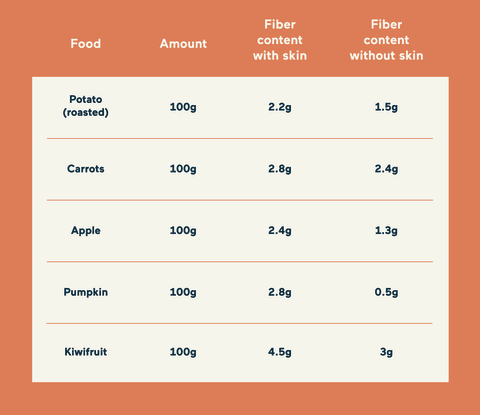
Naturopath and Nutritionist
Naturopath and Nutritionist
Katherine Maslen, N.D is a clinical naturopath, nutritionist, author, and podcast host living in Australia. She has her bachelor’s in health science, naturopathy, from the Endeavor College of Natural Health and authored authored Get Well, Stay Well.

Image by LightFieldStudios / iStock
February 3, 2023
Our editors have independently chosen the products listed on this page. If you purchase something mentioned in this article, we may
You’re cooking dinner and are just about to reach for the potatoes. Do you grab a peeler too? What if I told you that this is a nutritional blunder of epic proportions, and you’re basically throwing the most valuable part of your produce into the bin?
Advertisement
This ad is displayed using third party content and we do not control its accessibility features.
Why you’re better off leaving the skin on some fruits and vegetables.
It should come as no surprise that fiber is essential for your health1. The complex carbohydrate feeds your gut microbiome, supports digestion, helps regulate blood sugar, and assists with detoxification. Research shows that when we eat more fiber through whole foods or supplements, we lose weight more easily2—and we tend to consume fewer calories overall.
Chances are, there’s a good amount of fiber sitting in your trash can or compost bin right about now. Up to 31% of a vegetable’s fiber sits in its skin, so we’d be better off leaving the peels on in many cases. The fiber in fruit peels can also help fruit sugars get metabolized more slowly, preventing spikes in blood sugar.
This is easier with some foods than others. Leaving the peels on your carrots, for instance, is probably not going to blow your mind. But other things, such as eating the skin on your kiwifruit (a food-as-medicine intervention that I recommend in my naturopathic practice every day to improve gut health) can definitely seem weird if you’re not used to it.
There are many peels that you can eat, but there are some that you cannot. The skin of an avocado, mango, and cantaloupe, for example, is inedible. Here’s a bit of guidance on the produce peels that are high in fiber and how to use them:
A whopping 30-40% of a potato’s fiber is found in the skin, so you don’t want to be throwing that away. When I mash potatoes, I keep the skin on; same goes for roasted potatoes, potato bakes, and homemade chips.
I simply run the potatoes under water and wipe away the dirt with a vegetable brush. You don’t have to remove every eye and blemish! Small imperfections in your spuds are fine.
If you must peel your potatoes, you can save the peels, coat them in cold-pressed olive oil and sea salt, and roast them in the oven for high-fiber potato skin chips. Serve with guacamole for a real treat.
The same rules apply to sweet potatoes, except these are even easier because they tend to be less dirty on the surface.
Advertisement
This ad is displayed using third party content and we do not control its accessibility features.
Yes, you can eat the outside of a kiwifruit, and I’ve been doing it for years. Ever since I learned that it’s a super-beneficial food for gut health, I’ve been discarding kiwi tips and eating the fruit like I would an apple. If you eat the skin, you’ll get 50% more gut-loving fiber than if you eat the flesh alone.
If you’re new to this, I suggest running water over the skin first to reduce its furry texture. Make sure you remove the rough ends. They are technically edible, but even I wouldn’t go that far in the quest for fiber.
Around 45% of an apple’s fiber is found in the skin. Apple skins are also high in pectin, which is great for gut health3. Give them a good rinse under water and polish them with a cloth to remove any outer waxiness. Then chop, bite, or consume however you like. You can even leave the peels on for apple pie!
Advertisement
This ad is displayed using third party content and we do not control its accessibility features.
The stems of broccoli are higher in fiber than the florets, but these are often thrown away too. To preserve them, cut any brown bits off the ends of your broccoli, chop up the stems, and use them as you do your florets. They’re tasty in a stir-fry or bake, and using them up can save you a fair bit of food waste.
The skin of all types of pumpkins is edible, but some may realistically be too tough to eat. The best way to consume the skin is to roast it or barbecue it. If your recipe needs peeled pumpkin (pumpkin pie anyone?), then you can save the peels and roast them in the oven with a little olive oil and sea salt until brown and crispy.
Advertisement
This ad is displayed using third party content and we do not control its accessibility features.
Please stop peeling your carrots. Yes, the peels can be slightly bitter, but you’re throwing away fiber plus a heap of important nutrients4. Just give them a rinse under water, cut off any surface blemishes, and you’re good to eat them either raw or cooked.
If you’ve ever juiced a cucumber, you know that the only part that comes out is the green skin. Nearly the entire inside is water. The fiber and beneficial compounds like chlorophyll all collect in the skin, so don’t toss it. If your cucumber has seeds, try to include them too. They are another source of fiber that often gets thrown away.

Image by Katherine Maslen, N.D.
Advertisement
This ad is displayed using third party content and we do not control its accessibility features.
The takeaway.
The next time you’re cooking dinner, keep these peels on and enjoy the extra hit of fiber. By giving your produce the dignity of keeping its skin, you’ll do your gut (not to mention, the planet) a favor.
